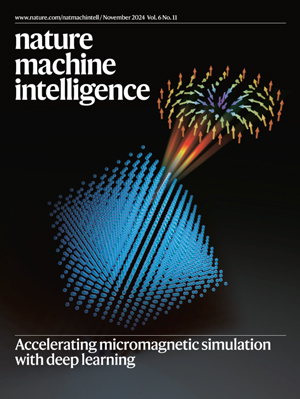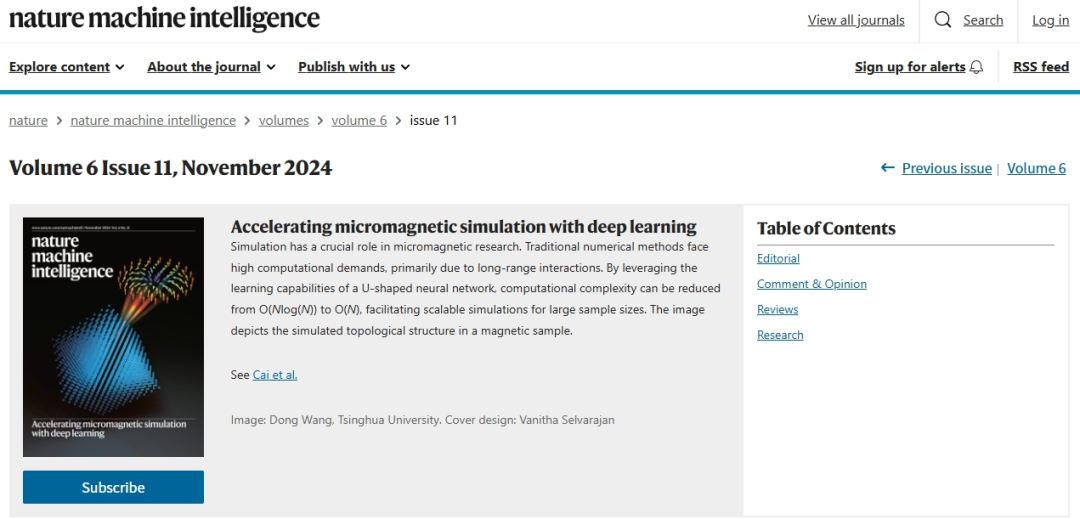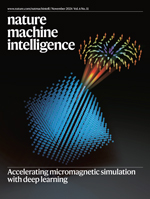
Nature Machine Intelligence volume 6, pages1330–1343 (2024)
Yunqi Cai, Jiangnan Li & Dong Wang
The cover of this issue of Nature Machine Intelligence is "Fast and generalizable micromagnetic simulation with deep neural nets", published by Associate Researcher Wang Dong from Beijing National Research Center for Information Science and Technology, Tsinghua University, and Associate Professor Li Jiangnan from Kunming University of Science and Technology.

Research Background
Micromagnetics has achieved significant progress due to its wide applications in the design of magnetic storage systems. As the cornerstone of micromagnetics research, numerical simulations rely on first-principles-based rules, employing the renowned Landau-Lifshitz-Gilbert (LLG) equation to compute the dynamic evolution of micromagnetic systems. However, these simulations are often hindered by slow computational speeds. Although Fast Fourier Transform (FFT) calculations can reduce computational complexity to O(Nlog(N)), they remain impractical for large-scale simulations. Therefore, there is a pressing need to explore new methods to accelerate the computational process of micromagnetics simulations.
Research Significance
This study introduces a deep learning approach named NeuralMAG to accelerate micromagnetics simulations. NeuralMAG adheres to the iterative framework of the Landau-Lifshitz-Gilbert equation but accelerates the computation of demagnetizing fields using a U-shaped neural network. This neural network architecture incorporates an encoder to extract aggregated spins at different scales and learn local interactions at each scale, followed by a decoder to accumulate these local interactions across scales, thereby approximating global convolution.
This divide-and-conquer strategy achieves a time complexity of O(N), significantly enhancing the speed and feasibility of large-scale simulations. Unlike existing neural methods, NeuralMAG focuses on core computations rather than task-specific end-to-end approximations, offering greater versatility.
Research Prospects
The success of NeuralMAG provides new perspectives and tools for micromagnetics simulations. Future research will further explore and optimize the U-shaped neural network architecture to improve computational accuracy and efficiency. NeuralMAG will be applied to a broader range of micromagnetics problems, including samples with different materials, shapes, and sizes, as well as more complex magnetization dynamics. This will help validate the versatility and reliability of NeuralMAG and promote its applications in magnetic storage design, magnetic material development, and other fields. Additionally, NeuralMAG will be integrated with existing physical models to more accurately describe the behavior of micromagnetic systems. Continued exploration and development of efficient algorithms and techniques will further enhance the speed and precision of micromagnetics simulations.
Cover design process
 |
The cover design revolves around the theme of ‘micromagnetism’ and its numerical simulation, aiming to convey the advanced nature and complexity of the research through visual elements. The design employs abstract three-dimensional graphics and coloured light beams as core elements to intuitively illustrate the dynamic evolution of micromagnetic systems and their integration with deep learning. The overall colour scheme of the cover features a black background, creating a mysterious and profound atmosphere that resonates with the microscopic world of micro-magnetism research. The three-dimensional graphics in the centre use a gradient from deep blue to light blue, reflecting the calmness and rationality of scientific research while also illustrating the dynamic changes in micro-magnetic systems through the transition of colours. The coloured light beams serve as highlights, adding a touch of vitality and hope to the cover, symbolising the breakthroughs brought by new technologies. |
The cover design combines modern minimalism with abstract art. The use of three-dimensional graphics highlights the complexity and multidimensionality of micro-magnetic systems, while the fireworks-like effect of the coloured light beams gives the cover a sense of dynamism and vitality. The overall design maintains the rigor of scientific research while incorporating artistic elements, making the cover more engaging. Ultimately, the cover received high praise from the professor and journal editors and was successfully published!
Our hours
Beijing time: 9:00-18:00